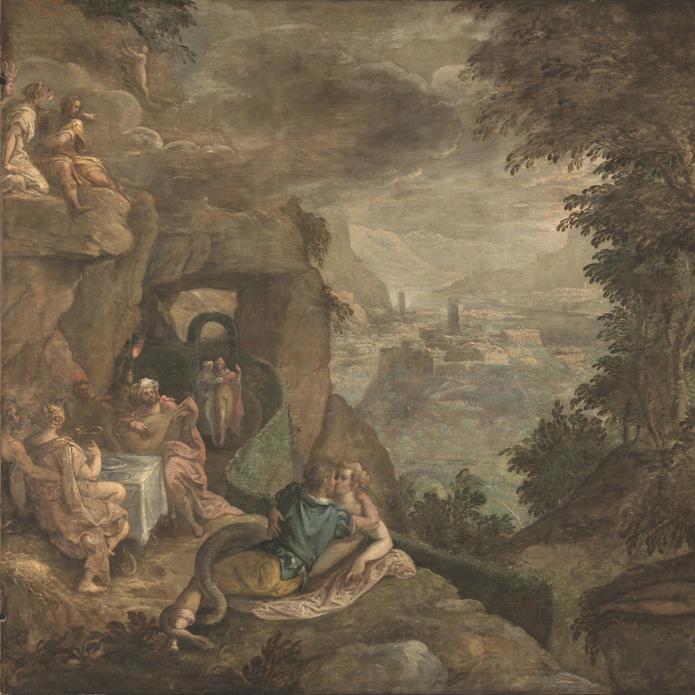Paolo Fiammingo, 'Landscape with the Expulsion of the Harpies', about 1590
About the work
Overview
As punishment for revealing the future to mankind, King Phineas of Thrace was blinded and had his food continually stolen by the harpies, who were half human and half bird. The story is told in the Argonautica, an epic romance written by Apollonius Rhodius during the third century BC.
A naked woman points to the sky as Zetes and Calais, the winged sons of Boreas, god of the north wind, put down food as bait to catch the dragon-like harpies. King Phineas stands beside the female figure of Fortune, pointing upward as the young Boreads launch themselves into the air to do battle in the clouds.
This painting and Landscape with a Scene of Enchantment (also in the National Gallery’s collection) may once have been part of a series of six or more paintings made to cover the upper walls of an entire room in a Venetian palace.
Key facts
Details
- Full title
- Landscape with the Expulsion of the Harpies
- Artist
- Paolo Fiammingo
- Artist dates
- About 1540 - 1596
- Part of the series
- Two Scenes from the Argonautica
- Date made
- About 1590
- Medium and support
- Oil on canvas
- Dimensions
- 185 × 206 cm
- Acquisition credit
- Bought, 1944
- Inventory number
- NG5467
- Location
- Not on display
- Collection
- Main Collection
Provenance
Additional information
Text extracted from the ‘Provenance’ section of the catalogue entry in Nicholas Penny, ‘National Gallery Catalogues: The Sixteenth Century Italian Paintings’, vol. 2, ‘Venice 1540–1600’, London 2008; for further information, see the full catalogue entry.
Bibliography
-
1955The National Gallery, The National Gallery: 1938-1954, London 1955
-
1959Gould, Cecil, National Gallery Catalogues: The Sixteenth Century Venetian School, London 1959
-
1987Gould, Cecil, National Gallery Catalogues: The Sixteenth Century Italian Schools, London 1987
-
2001
C. Baker and T. Henry, The National Gallery: Complete Illustrated Catalogue, London 2001
-
2008Penny, Nicholas, National Gallery Catalogues: The Sixteenth Century Italian Paintings, 2, Venice, 1540-1600, London 2008
About this record
If you know more about this work or have spotted an error, please contact us. Please note that exhibition histories are listed from 2009 onwards. Bibliographies may not be complete; more comprehensive information is available in the National Gallery Library.
Images
About the series: Two Scenes from the Argonautica

Overview
These two very large canvases may once have been part of a series of perhaps six or more paintings which would have decorated the walls of a whole room in a Venetian palace, like wallpaper today. They were painted hastily using only a limited range of colours, which may be because they were intended as interior decoration rather than as gallery pictures.
Landscape with the Expulsion of the Harpies illustrates a scene from the Argonautica, an epic romance written by Apollonius Rhodius in the third century BC. The hybrid women in Landscape with a Scene of Enchantment could be beastly followers of Circe also described in the Argonautica (Book IV) and the sleeping man may be Odysseus. The very specific elements in this scene suggest that it illustrates a particular story, although we do not know which one.


